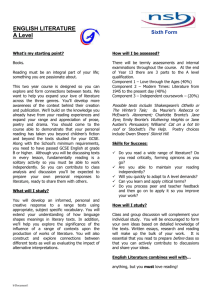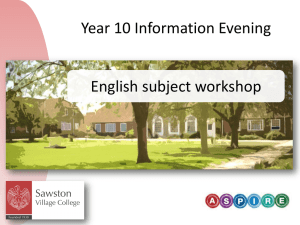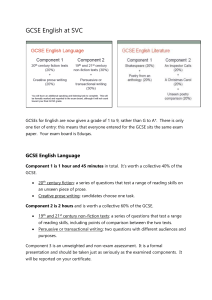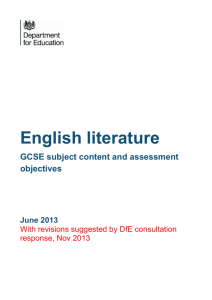Teach-English Resource Pack Introduction-PETA
advertisement
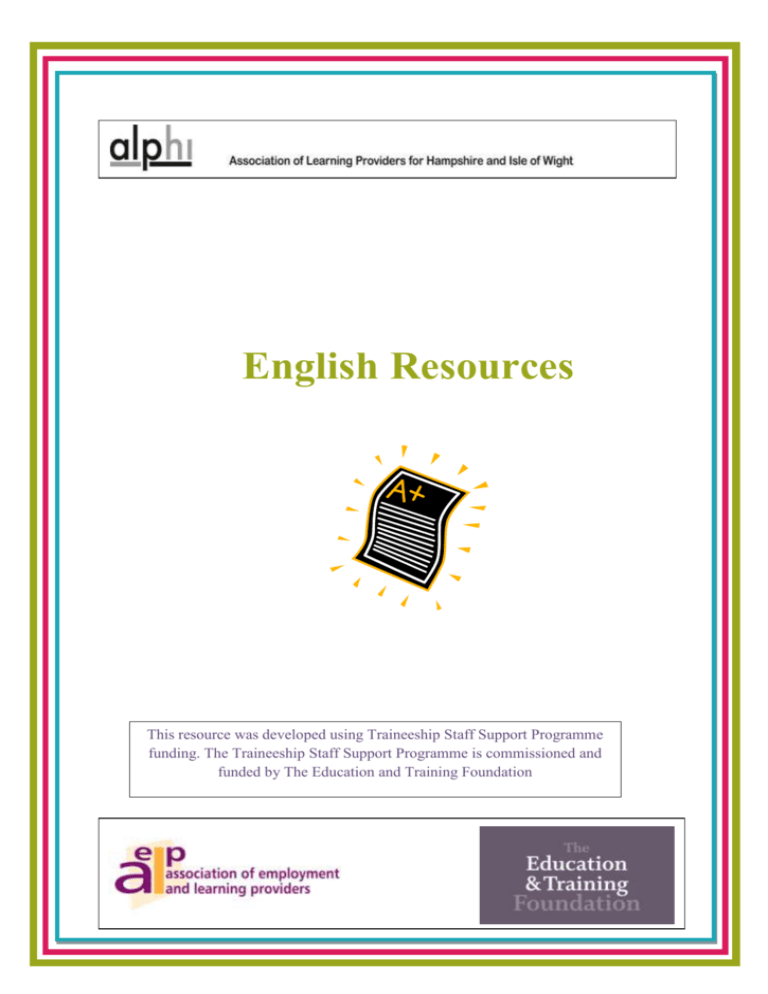
English Resources This resource was developed using Traineeship Staff Support Programme funding. The Traineeship Staff Support Programme is commissioned and funded by The Education and Training Foundation English Resources Introduction This pack contains a variety of resources created by delegates from training providers to support the teaching of English qualifications. The group attended two days of training to explore the requirements of GCSE English from 2015. Prior to the training, delegates completed questionnaires on their knowledge and confidence in teaching the key assessment objectives: Writing Assessment Objectives - Communicate clearly, effectively and imaginatively, selecting and adapting tone, style and register for different forms, purposes and audiences - Organise information and ideas, using structural and grammatical features to support coherence and cohesion of texts - Candidates must use a range of vocabulary and sentence structures for clarity, purpose and effect, with accurate spelling and punctuation. (This requirement must constitute 20% of the marks for each specification as a whole.) Reading Assessment Objectives - Identify and interpret explicit and implicit information and ideas - Select and synthesise evidence from different texts - Explain, comment on and analyse how writers use language and structure to achieve effects and influence readers, using relevant subject terminology to support their views - Compare writers’ ideas and perspectives, as well as how these are conveyed, across two or more texts - Evaluate texts critically and support this with appropriate textual references The outcomes of these questionnaires were used to provide bespoke training on key areas of the English Curriculum. The two days were structured as follows: Day 1 1) Outline of changes to GCSE English 2) Summary of questionnaire findings 3) Support in relation to findings (focusing on writing). 4) Preparation for group resourcing activity Day 2 1) Sharing of teaching resources by tutor (focusing on reading) 2) Sharing of resources in groups 3) Revisit questionnaire and feedback The sessions have resulted in a wide variety of resources aimed at developing appropriate skills for the new Linear GCSE exams. We hope they prove useful. Contributors Below are the names of those people who attended the sessions on 22nd May and 13th June and who contributed to the resources contained in this pack. ALPHI thank all of them for their participation and their contribution to the resources that, through their efforts, are now available to the wider network. Thank you! Company Delegate name Care Learning Centre Emma Curtis Care Learning Centre Natalie Caldwell Chiltern Training Ltd Janet Buckett Chiltern Training Ltd Michele Turner Eastleigh College Debbie Hughes Eastleigh College Charlotte Drury Enham Trust Mark Leyton Enham Trust Salma Sams Enham Trust Hannah Griffiths Enham Trust David How HIT Training Laura Foster MPCT Kerry Salter PETA Limited Andy Clayton PETA Limited Jane Mitchell SCL Gareth Pritchard SCL Lee Innes SCL Tony Linton TQ Eductation Eileen Poole Waverley Training Barbara Milam Suggestions for how to use the resources From 2015, GCSE English will be linear; students will no longer be able to submit coursework or controlled assessments. Their GCSE grade will be based entirely on two written exams taken at the end of the course. All texts in these exams will be unseen, so the delivery of the course needs to be entirely skills based. Speaking and listening will still be assessed, but it will be reported separately. Although speaking and listening will not count towards their final GCSE English Language grade, talk remains a fundamental part of developing skills as a reader and writer. The exams will each contain a reading and writing section. In the reading sections, students will come across texts from the 19th, 20th and 21st centuries. These texts may be fiction or non-fiction depending on the exam board. They will be assessed on their ability to: Identify and interpret explicit and implicit information and ideas Select and synthesise evidence from different texts Explain, comment on and analyse how writers use language and structure to achieve effects and influence readers, using relevant subject terminology to support their views Compare writers’ ideas and perspectives, as well as how these are conveyed, across two or more texts Evaluate texts critically and support this with appropriate textual references For more specific information, please see the Comparison Grid document available in the GCSE Outline and Draft Specification Information folder. This document outlines the DRAFT specifications of the 4 exam boards; information from the draft papers has also been provided, so you see range of tasks students are likely to come across. Section B of each exam will involve a writing task. Students will be assessed on their ability to: Communicate clearly, effectively and imaginatively, selecting and adapting tone, style and register for different forms, purposes and audiences Organise information and ideas, using structural and grammatical features to support coherence and cohesion of texts Candidates must use a range of vocabulary and sentence structures for clarity, purpose and effect, with accurate spelling and punctuation. (This requirement must constitute 20% of the marks for each specification as a whole.) With these skills in mind, the delegates have designed resources to support different elements of the curriculum. A number are based on developing skills in English using their particular vocational area. However, there is nothing to stop you using these resources elsewhere. All of these resources are found in the GCSE English Resources folder. The more holistic nature of the course means that it is difficult to separate the resources into reading and writing folders or into distinct exam components. Resources have been divided up into the following folders for ease of use: Folder number and title 1) Creative Writing Folder content overview / index Creative writing activities Fairy tales and book extracts Writing for an audience 2) Letter Writing Letter writing 1 Letter writing 2 Letter writing 3 3) Persuasive Writing, Counter argument and Bias Persuasive writing – punctuation activities Persuasive writing and counter arguments Positive and negative descriptors 4) Sentence Types, Comprehension and Text Analysis Comparing sentence structures Comprehension and text analysis 5) Writing to inform Activity – writing to inform




